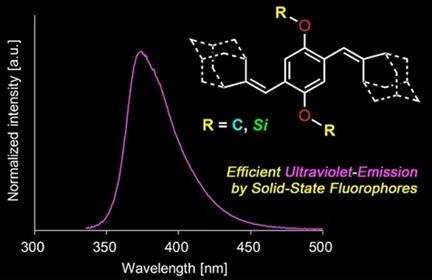当前位置:
X-MOL 学术
›
Chem. Eur. J.
›
论文详情
Our official English website, www.x-mol.net, welcomes your
feedback! (Note: you will need to create a separate account there.)
Efficient Emission of Ultraviolet Light by Solid State Organic Fluorophores: Synthesis and Characterization of 1,4-Dialkeny-2,5-dioxybenzenes.
Chemistry - A European Journal ( IF 3.9 ) Pub Date : 2020-09-23 , DOI: 10.1002/chem.202003526 Masaki Shimizu 1 , Kenta Nishimura 1 , Rika Hirakawa 1 , Tsuneaki Sakurai 1
Chemistry - A European Journal ( IF 3.9 ) Pub Date : 2020-09-23 , DOI: 10.1002/chem.202003526 Masaki Shimizu 1 , Kenta Nishimura 1 , Rika Hirakawa 1 , Tsuneaki Sakurai 1
Affiliation

|
The design and development of organic luminophores that exhibit efficient ultraviolet (UV) fluorescence in the solid state remains underexplored. Here, we report that 1,4‐dialkenyl‐2,5‐dialkoxybenzenes and 1,4‐dialkenyl‐2,5‐disiloxybenzenes act as such UV‐emissive fluorophores. The dialkenyldioxybenzenes were readily prepared in three steps from 2,5‐dimethoxy‐1,4‐diacetylbenzene or 2,5‐dimethoxy‐1,4‐diformylbenzene via two to four steps from 1,4‐bis(diethoxyphosphonylmethyl)‐2,5‐dimethoxybenzene. The dialkenyldioxybenzenes emit UV light in solution (λem=350–387 nm) and in the solid state (λem=328–388 nm). In addition, the quantum yields in the solid state were generally higher than those in solution. In particular, the adamantylidene‐substituted benzenes fluoresced in the UV region with high quantum yields (Φ=0.37–0.55) in the solid state. Thin films of poly(methyl methacrylate) doped with the adamantylidene‐substituted benzenes also exhibited UV emission with good efficiency (Φ=0.27–0.45). Density functional theory calculations revealed that the optical excitation of the dialkenyldimethoxybenzenes involves intramolecular charge‐transfer from the ether oxygen atoms to the twisted alkenyl‐benzene‐alkenyl moiety, whereas the dialkenylbis(triphenylsiloxy)benzenes were optically excited through intramolecular charge‐transfer from the oxygen atoms and twisted π‐system to the phenyl‐Si moieties of each triphenylsilyl group.
中文翻译:

固态有机荧光团对紫外线的有效发射:1,4-二烯基-2,5-二氧苯的合成与表征。
在固态中表现出有效的紫外线(UV)荧光的有机发光体的设计和开发仍未得到开发。在这里,我们报道了1,4-二烯基-2,5-二烷氧基苯和1,4-二烯基-2,5-二甲硅烷氧基充当此类UV发射荧光团。二烯基二氧基苯可以很容易地从3,5-二甲氧基-1,4-二乙酰苯或2,5-二甲氧基-1,4-二甲酰苯分三步制备,从1,4-双(二乙氧基膦酰基甲基)-2-5分两步制备。 -二甲氧基苯。所述dialkenyldioxybenzenes发射UV光在溶液中(λ EM = 350-387纳米)和在固体状态(λ EM= 328–388 nm)。另外,固态的量子产率通常高于溶液中的量子产率。特别是金刚烷取代的苯在紫外区以固态发出高量子产率(Φ = 0.37–0.55)的荧光。掺杂有金亚甲基取代苯的聚甲基丙烯酸甲酯薄膜也具有良好的紫外线发射率(Φ= 0.27–0.45)。密度泛函理论计算表明,二烯基二甲氧基苯的光激发涉及分子内电荷从醚氧原子转移到扭曲的烯基-苯-烯基部分,而二烯基双(三苯基甲硅烷氧基)苯是通过氧内分子内电荷转移而被光激发的。原子和扭曲的π系统到每个三苯基甲硅烷基的苯基-Si部分。
更新日期:2020-09-23
中文翻译:

固态有机荧光团对紫外线的有效发射:1,4-二烯基-2,5-二氧苯的合成与表征。
在固态中表现出有效的紫外线(UV)荧光的有机发光体的设计和开发仍未得到开发。在这里,我们报道了1,4-二烯基-2,5-二烷氧基苯和1,4-二烯基-2,5-二甲硅烷氧基充当此类UV发射荧光团。二烯基二氧基苯可以很容易地从3,5-二甲氧基-1,4-二乙酰苯或2,5-二甲氧基-1,4-二甲酰苯分三步制备,从1,4-双(二乙氧基膦酰基甲基)-2-5分两步制备。 -二甲氧基苯。所述dialkenyldioxybenzenes发射UV光在溶液中(λ EM = 350-387纳米)和在固体状态(λ EM= 328–388 nm)。另外,固态的量子产率通常高于溶液中的量子产率。特别是金刚烷取代的苯在紫外区以固态发出高量子产率(Φ = 0.37–0.55)的荧光。掺杂有金亚甲基取代苯的聚甲基丙烯酸甲酯薄膜也具有良好的紫外线发射率(Φ= 0.27–0.45)。密度泛函理论计算表明,二烯基二甲氧基苯的光激发涉及分子内电荷从醚氧原子转移到扭曲的烯基-苯-烯基部分,而二烯基双(三苯基甲硅烷氧基)苯是通过氧内分子内电荷转移而被光激发的。原子和扭曲的π系统到每个三苯基甲硅烷基的苯基-Si部分。











































 京公网安备 11010802027423号
京公网安备 11010802027423号